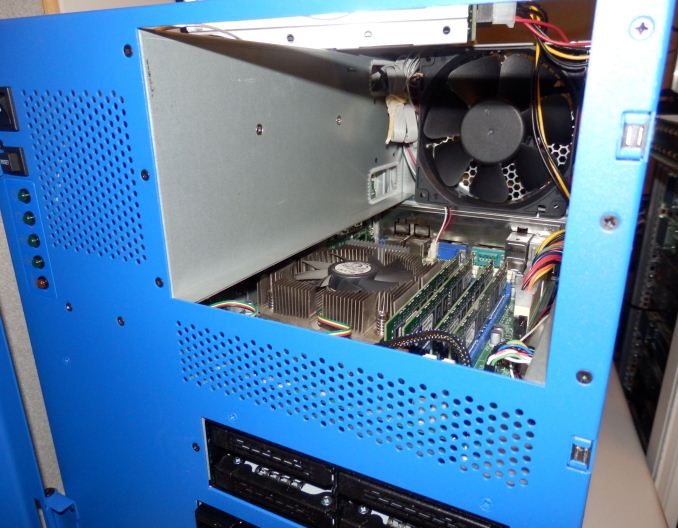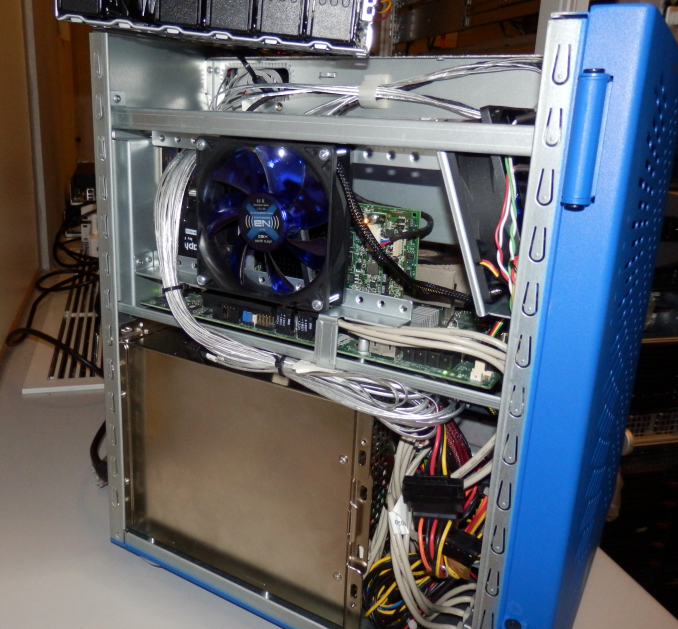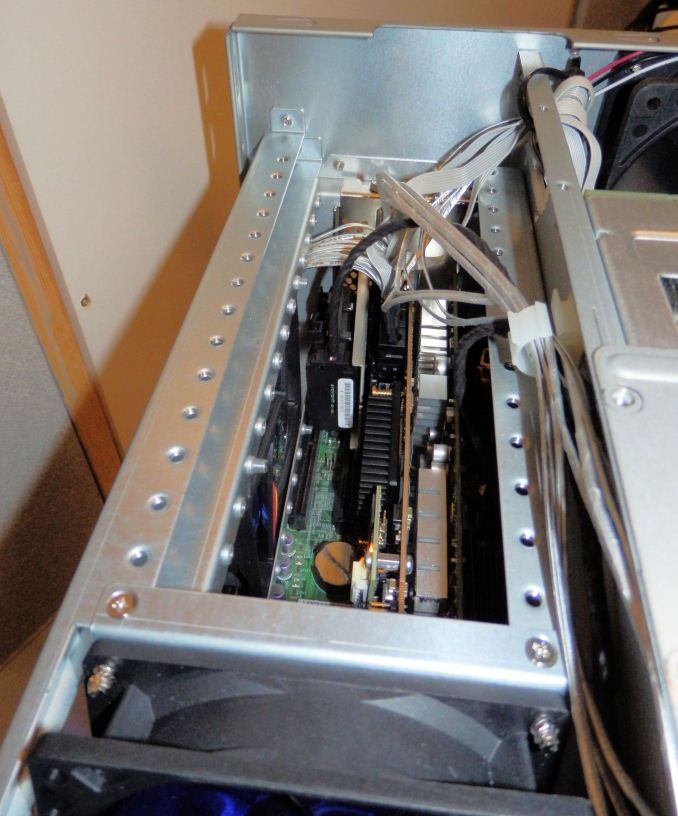Advatronix Cirrus 1200: a Storage Server Under Your Desk
by Johan De Gelas on June 6, 2014 5:00 AM ESTA Look Inside
Since the Advatronix Cirrus 1200 is a mix between a desktop and a server chassis, we felt we should investigate the internals a bit more closely than we would with a typical rack server. First, we removed the storage bays.
The Cirrus 1200 chassis consists mostly of the two drive modules with six 3.5" disk bays in each. A large 120mm keeps the drive bays cool but the large 3.5" drive bays obstruct the airflow over the motherboard and CPU heatsink. As a result, a fan on top of the CPU heatsink is necessary, which is not optimal if you want a highly available and easy to service server. A larger heatsink positioned next to the drive module and not under the module with cooling provided by the large and easy to replace fan at the back would make the Cirrus more "server grade".
The RAID card and optional 10G Ethernet card on the left are cooled by two fans. One fan blows from the front and one blows from the left.
The last fan seems to be there for redundancy reasons as the front fan is enough to cool the heatsink of the RAID card. The fans are easy enough to reach, but we would prefer easier and faster hot-pluggable fans that can be replaced without using a screwdriver.
Three PCIe slots are available, but the Battery Backup Unit of the Adaptec RAID controller covers the third PCIe slot. Considering the target market of the Cirrus 1200, that is hardly an issue. In total you can get two 10G Ethernet and two 1Gb Ethernet interfaces, which should be sufficient for the target market.













39 Comments
View All Comments
Kevin G - Friday, June 6, 2014 - link
It really comes down to scale. A single system, regardless if it is a 4U server or a gaming rig can be run in a home environment and not have to worry too much about cooling. Sure, putting them in a closet with the door closet will cause them to bake but that'd be true of any high power piece of electronics.For a single server, a CRAC is overkill. When dealing with a room with hundreds of racks, each full of servers, a CRAC is necessary to deal with the heat output. CRAC's are also designed with datacenter RAS methodology. They're highly modular to ease service, typically fit into standard rack row and have monitoring capabilities. Multiple CRAC's can also load balance the cooling needs of a room or act has a 'hot spare' in case another unit fails. These are features you don't find in home air conditioning units.
There is also another thing to factor in comparing a gaming rig with server: size. Common servers are either 1U or 2U in height which means they'll use small high RPM fans internally. This means they're loud and there are a lot of them. Cooling for rack servers is done in one direction: front to back. A gaming rig tends to have plenty of room. Larger, lower RPM fans *can* move more air than several smaller 80 mm fans. In addition, the typical gamer case has more area to draw into it as well as for exhaust. In otherwords, a gaming case is less restrict in terms of airflow for cooling.
sciencegey - Saturday, June 7, 2014 - link
It isn't to do with power draw, it's the fact that your PC isn't running 24/7 with loads of HDDs (which create a lot of heat) and the fact that they will be running at around about 60% load constantly. Also, CRAC is just a fancy way of saying air conditioning.Ratman6161 - Friday, June 6, 2014 - link
Ummmmm. If your business relies on this data then it shouldn't be "under your desk".And don't forget your UPS and your offsite backups either. Another issue I see is that a company of a size that might be looking at something like this probably doesn't have any IT support in house to manage those backups and disaster recovery procedures. Unfortunately that's just the sort of situation where I find businesses doing this sort of thing. An amateur sets something up "under his desk" but when it fails they are screwed. Or when that person leaves the company they are screwed.
So there are probably certain niches where this sort of system could be useful but if a company doesn't either have IT staff or at least a support contract to manage things, it's very likely they would be better off in the cloud - if only for disaster recovery purposes.
Gunbuster - Friday, June 6, 2014 - link
The Dell T620 has a chassis option for 32 2.5" Hard Drivesvalinor89 - Friday, June 6, 2014 - link
"Moreover, while renting a few Terrabytes in the cloud has become relatively affordable..."Terrabytes is meant as a joke or a typo? It sounds cool anyway.
rpg1966 - Friday, June 6, 2014 - link
Terrabytes!https://d2kxqxnk1i5o9a.cloudfront.net/uploads/pict...
thunderbird32 - Friday, June 6, 2014 - link
Fujitsu is a weird company. I've never been able to find a reseller that carries their x86 servers or workstations. One wonders how much business they do in that category in the US.JohanAnandtech - Tuesday, June 10, 2014 - link
Thanks for sharing. Each time I went to Cebit, the people at Fujitsu had little interest talking to me, as I was international press. It is like the x86 line is their just to complete their product portfolio.Drizzt321 - Friday, June 6, 2014 - link
I would have liked to have seen an option to ditch the RAID cards and move to simple HBA cards to allow OS management of the arrays. Would also probably decrease the cost by a good bit.sciencegey - Saturday, June 7, 2014 - link
This thing seems kinda pointless because if you are a small business, you can get a cheap server rack and then get a storage server and even have places to put your network switch and VoIP box. This means you won't have to take up precious office space (you can mount server racks on walls) with this giant blue box. If you are really too cheap for a server rack-mount system, then you would probably just build your own file server, which is pretty easy (if you love Linux, make you own distro, use current distros like FreeNAS or shell out to get Windows Server. And if you are using Macs, then you just use a Time Machine/hackintosh as a Time Machine).